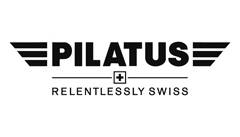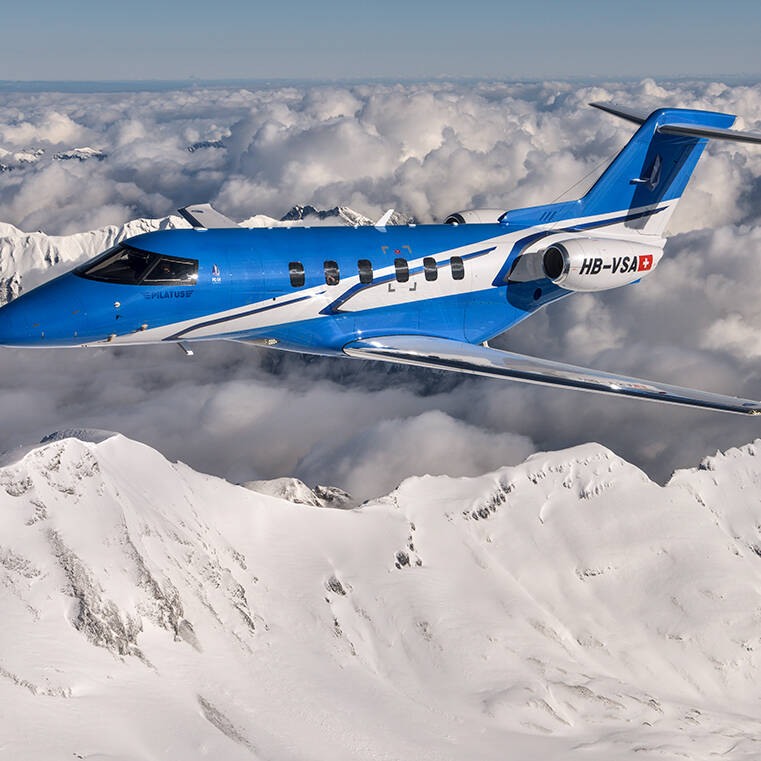
With composites to new horizons
With a weight of only 5 tons (11,000 lbs), the new Pilatus PC-24 business jet is light enough to take off and land on short, grassy runways. Its low weight stems from the use of components made of carbon and glass fiber. For processing these materials, Pilatus relies on state-of-the-art Zünd cutting technology.
08:10 in Fano, Central Italy: a PC-24 prepares for landing at Aeroporto di Fano. The executive on board is scheduled to attend a meeting at 9 o'clock, just two kilometers away. It's an unusual scenario, in that the aircraft is a brand-new business jet, a PC-24 manufactured by Pilatus Aircraft AG, and the runway is unpaved, bumpy, and measures a mere 1,300 meters. Typically, jets of this class land in Rimini, which after arrival would entail driving another 1.5 hours to the meeting location near Fano.
Landing on short, unpaved grass and gravel runways was previously reserved for turboprop airplanes. As of recently, however, this type of terrain is no longer off limits to the new PC-24. It can take off after just 890 meters and requires only 720 meters for landing. This is in part due to its base weight of only 5.3 tons (less than 12,000 lbs). The low weight is brought about by the numerous carbon and glass-fiber components which make up the PC-24. For its cutting operations, Pilatus has for years relied on technology from the Rhein Valley in Switzerland. In 2018 Pilatus decided once again to opt for a highly automated Zünd digital cutting system.
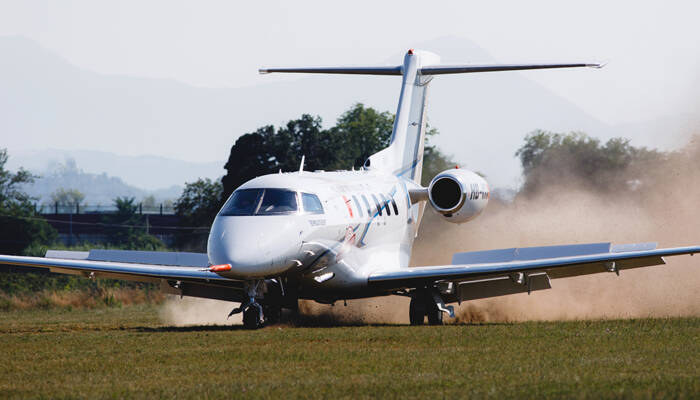
How to build an airplane?
Patrick Rohrer, Pilatus' Project Manager System Procurement, knows what it takes to successfully build airplanes: "Commitment to production location and the "Swissness" that goes along with it are one thing; but at least as important are state-of-the-art production cells equipped with cutting-edge technology." Key to this are permanent reduction of costs, productivity optimization, and the ability to implement modern production technologies.
Things were different back in 1959. That's when the PC-6 Porter took off for the very first time at Stans Airfield near Lucerne, Switzerland. It was a sturdy, all-metal universal aircraft that many would refer to as a "Jeep with wings" – a plane with the versatility of a Swiss Army Knife. The PC-6 were assembled exclusively by hand. This necessitated an experienced workforce and tolerances that were much greater than they are today. The company's latest aircraft type, the PC-24, consists of innumerable parts, many of them milled at tolerances in the Mμ range. Assembly is much faster now, made possible only because of the latest advances in production technologies.
As of this year, the PC-6 is no longer being built, a success story that came to an end after a production run of 500 planes. Its successor, the PC-12, which has been sold globally more than 1,650 times since 1994, is the most popular single-engine turboprop aircraft on the market.
Pilatus began using carbon fiber parts early on in its history of manufacturing airplanes. Already for the PC-6, first GFRP and CFRP components were laid up by hand, albeit still in limited quantities.
In the aircraft industry, almost everything revolves around weight reduction. As a result, more and more parts are made from carbon and glass fiber. Major advantages of these materials are their high rigidity and toughness, as well as their wear resistance. The challenge, however, lies in balancing weight, stability, and cost. "In addition, there are factors such as payload and usable space that have to be maximized as much as possible." At Pilatus no load-bearing parts are made of CFRP, but the company's R&D is busy working on that. The PC-24 uses composites mainly for interior and exterior cladding. The engine casings and wingtips, too, are made of carbon fiber, as well as landing gear doors, air ducts, various pipes, covers, and trailing edges on wings.
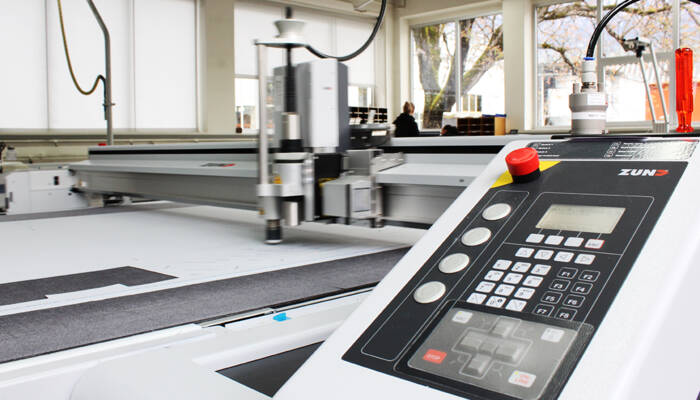
Prepreg, the future of aircraft manufacturing
The starting point for these aircraft parts is prepreg, pre-impregnated carbon fiber. Endless, pre-impregnated fibers are consolidated through pressure and high temperature. These prepregs offer high durability and rigidity, are flame retardant, resistant to fatigue and wear as well environmental degradation.
Prepreg is delivered in rolls by refrigerated trucks and stored in freezers at -19 degrees C (-2.2 F). To bring the material to room temperature for processing, it is taken out of the cooler the night before. It can remain at room temperature for 5 to 20 days before the resin begins to react and cure. Pilatus processes around five rolls of approx. 90 m2 daily, or about 90'000 m2 per year. And the rate of consumption is steadily increasing; today more than half of all CFRP and GFRP components produced in the company's plastics department are installed in the new PC-24. For cutting prepreg, Pilatus has relied on Zünd digital cutting for more than 15 years. The PN-series cutter purchased at the time continues to reliably perform its duties; however, increased demand for carbon fiber components began to exceed capacity, This led to the addition of a state-of-the-art Zünd G3 L-2500 in 2019. The G3 system single-ply cuts materials for the respective components in a largely automated process and labels cut pieces with an integrated inkjet module.
Once cutting is completed, the parts are kitted and put in cold storage until further processing. Depending on rigidity and strength requirements, a component can consist of up to 350 layers.
If no DXF file is available for parts or their individual layers, a digitizer comes into play that allows for easy capture and digitization of part templates placed on the digitizing table. This allows for easy capture and digitization of part templates placed on the digitizing table. Even minor changes to components previously released by the engineering department can be easily carried out and digitized using this system.
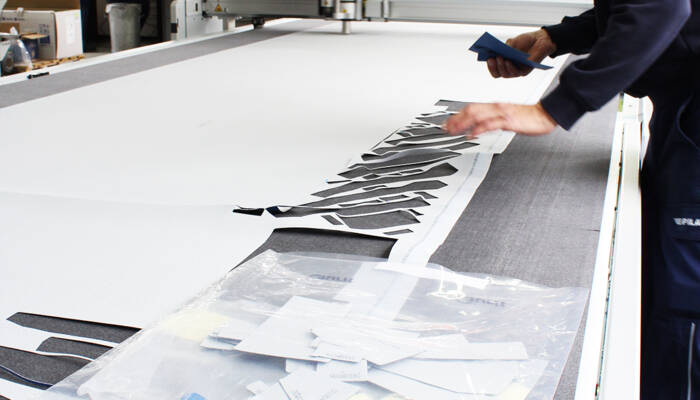
Material efficiency is always a concern
Another factor in Pilatus' success has been the focus on implementing permanent productivity increases. Explains Patrick Rohrer: "When dealing with cost-intensive materials such as carbon or glass fiber, material efficiency and optimization are always a concern. We are constantly working to increase utilization and thereby reduce waste —particularly since we still have few options for recycling". In the meantime, waste rates have been reduced from 30% to 20%. The highly efficient nesting features in Zünd Cut Center - ZCC software play an important role in this. On one hand, cut parts are statically nested. This means parts, or rather their individual layers, are nested to create a set layout used repeatedly to complete the entire job. "Dynamic nesting, meaning parts and layers from multiple jobs are nested and combined in a single cut file, is also used whenever it makes sense." This further increases the degree of utilization of the raw material.
Zünd's unique turnkey solution
The fact that Zünd was awarded the contract for updating the company's plastics department is due in part to certain similarities between the two companies, as well as to Zünd's ability to offer unique, modular, and comprehensive solutions, as Patrick Rohrer puts it. Like Pilatus, Zünd is committed to Switzerland as production location. This is where Zünd, with its highly qualified workforce and state-of-the-art technology, develops high-tech solutions for global distribution. So the short distance that separates the two companies has also contributed significantly to our successful cooperation, concludes Rohrer. "The fact that we can look back on 15 years of experience with Zünd cutting technology is important. Zünd offers open and modular solutions with optional service contracts and extremely reliable software without short-lived updates. Exactly what we understand by real customer benefit." And Zünd attaches great importance to providing exemplary customer service – yet another trait the two companies have in common.
